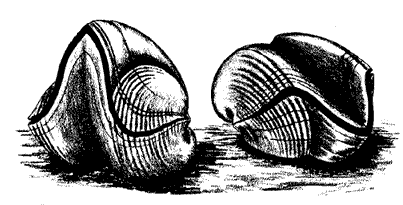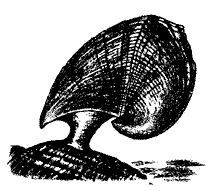Order Spiriferida
(Ordovician-Jurassic)
The spiriferids are a very variable group of brachiopods. Members of this group can have punctate or impunctate shell microstructure, strophic or astrophic hinge line, and of any of a number of gross shell morphology. Their only defining quality is the presence of a spiral brachidium; that is, a spiral support for the lophophore (spiralia). This admittedly is not a very reliable feature, in view of the common brachiopod tendency to homeomorphy, and it has recently been suggested that some if not all of the four main suborders of Spiriferids are actually distinct, even unrelated orders which independently evolved the distinctive spiral brachidium. I have followed the most current classification in separating the Atrypids and Athyrids into separate orders. Both of these groups are thought to have descended from rhynchonellid ancestors. The punctate spiriferids are a small but varied (possibly artificial) assemblage and are here retained within the order Spiriferida.
Order Spiriferida
or Suborder Spiriferidina

Paraspirifer
early and Early Devonian
length about 4 cm - width about 4.5 cm
mode of life: attached when young, but its pedicle disappeared in maturity and the shells lay in the mud.
illustration from Fenton & Fenton, The Fossil Book, 1958, Doubleday & co., p.120
The Spiriferids proper are characterized usually by the familiar "spirifer" shape with wide or extended hinge line; in fact the hinge-line is often the widest part of the shell, and in some genera (e.g. Mucrospirifer) it is greatly elongated. Nearly all shells bear costae or plications, and they are almost invariably marked by a well-developed sulcus on the pedicle valve and a fold on the brachial valve. The surface is either plicate or coilate and may bear much finer markings. The beak is prominent, and a curved, generally obtuse-angle interarea occurs on the pedicle valve. Directly beneath the beak, the interarea is interrupted by the delthyrium, which may be partly closed by a deltidium.
The spiral brachidium of these brachiopods is remarkably developed, the cone-shaped coils on either side of the median plane being formed of many turns. The spiral brachidia extend outward toward the extremities rather than into the brachial valve. Internal structures are varied, and in some shells they are important in generic diagnosis. Generally, there are large muscle scars, stout dental lamellae, closely coiled, outwardly pointed spiralia, and simple jugum.

Brachyspirifer
Early Devonian
length about 3 cm - width about 4.5 cm
mode of life: had a thick pedicle that probably was attached to large shells, corals, etc., throughout the animal's life
illustration from Fenton & Fenton, The Fossil Book, 1958, Doubleday & co., p.120
Evolutionary history
The spiriferids evolving from the orthids at the end of the Ordovician, developing a coiled brachium independently of the Atrypids and Athyrids. The Spiriferids remain rare during the Silurian, but undergo a dramatic evolutionary radiation during the following, Devonian period, reaching a peak development in variety and numbers at that time. a prominent brachiopod assemblage. Devonian forms were very diverse, including some types with a nonplicated fold and sulcus, various others with evenly spaced coarse or medium to fine plications, and one lineage that is planoconvex in form (i.e. one valve flat, the other bulbous). Cyrtina, with its deep pedicle and opening for a large pedicle, is a well-known Devonian genus. The group undergoes something of a decline during the Early Carboniferous, although still remaining very common (second only to the productids in abundance). Spirifer, a typical genus of this time (top of page), is characterized by plicate shells with a wide hinge line. Late Carboniferous and Permian Spiriferids are characterized especially by bifurcation and bundling of plications on the shell surface. Only a few punctate-shelled forms (which may or may not belong to a distinct order) make it through to the Jurassic.
Spriferidina Late Ordovician--Late Permian)
Cyrtioidea (Late Ordovician--Early Devonian)
Spinelloidea (Late Silurian -- Late Devonian)
Theodossioidea (Early Devonian-Early Carboniferous-?Late Carboniferous)
Cyrtospiriferoidea (Early-Late Devonian)
Ambocoelioidea (Late Silurian-Late Permian)
Martinioidea (Late Silurian-Late Permian)
Spiriferoidea (Late Devonian-Late Permian)
Brachythyridoidea (Early Devonian-Late Permian)
Paekelmanelloidea (Late Devonian-Late Permian)
Delthyridina Early Silurian-Late Permian.
Delthyridoidea (Early Silurian-Early Devonian)
Reticularioidea (Early Silurian-Late Permian)
Order Spiriferidida or Suborder Spiriferinina
Cyrtinidina Early Devonian-Early Jurassic).
Cyrtinoidea (Early Devonian-Early Carboniferous)
Suessioidea (Early Carboniferous-Early Jurassic)
Spondylospiroidea (Late Triassic)
Pennospiriferinoidea (Late Devonian-Early Jurassic)
Spiriferinoidea (Middle Triassic-Early Jurassic)
The Spiriferidida, previously called Punctospiracea, are distinguished from other spire-bearing (spiriferid) brachiopods by their punctate shell structure. As with other groups of punctate shells, such as terebratulids and dalmanellaceans, the presence of puncta constitutes a basis which is presumed to justify this separation. In all other respects though this is a very variable group, and may perhaps be polyphyletic. For the time being I have left these forms with the Spiriferids proper. Many of these forms had high cardinal areas and coarse plications, although others were much more like conventional (impunctate) spiriferids.
Classification from Classification des Brachiopoda (Lophophorata)
|

Brachiopoda main page
|



